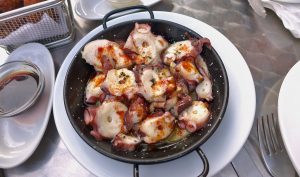The Goulash Story
Culinary experts state that a perfectly prepared Goulash is a feast to the senses. The rich aroma of the stew holds secrets of slow cooking for thousands of years. Moreover, the texture, color and viscosity determines the expertise of the chef and sometimes the nationality!
As surprising as this may sound, many Central European nations consume this dish in significant portions. Therefore, it comes with regional varieties that can be detected from country to country.
A Private Foodie Tour in Hungary, Highly Recommended!
The dish originated in medieval Hungary among the shepherds of the lands. It is a paprika seasoned soup of meat and vegetables. However, this would be a huge understatement of this gourmet dish.
This food awakens the senses with its rich aroma of thick meat stew, skillfully mixed with boiled vegetables. Notably, That is one of the ancient techniques of slow cooking that carries much of the secrets of healthy recipes and rich tastes.
Historically, the shepherds cooked the meat and left it outside to dry in the sun. Later, they stored it in sheeps’ stomach bags for future consumption. As this may sound too much of a bizarre method for storage, let’s remember that it was between the 8th and the 9th century. At that time, refrigeration was a totally different practice that relied on utilizing natural resources.
Hungarians Eating Habits and Traditions

Hungarians eat well and enjoy their food. Dining is an event as well as a tradition for the whole family. Therefore, it is a chance to gather around one big table and discuss warm talks over warm foods.
Sunday family lunch is sacred in Hungary. As a result, many Hungarians dress up in their finest clothes. Women wear their makeup and accessories, while men show up in smart casual or elegant suits.
Hungarians carefully choose the venue to have their feast on the weekends. This place is usually a local restaurant that specializes in Hungarian dishes. Their food usually hosts a three-course meal. Hence, this provides the needed hours to thoroughly discuss family topics and enjoy a quality time.
Hungarians, like most other Central European nations, are fond of meats. They mostly eat pork and beef. Moreover, they compete with the Germans in their love for sausages.
However, the distinguishing factor of the Hungarian food would be their bread. With limitless varieties, most of Hungarian meals are accompanied with wheat based products. Consequently, they are known for dipping huge amount of breads into their meals. Alternatively, bread is sometimes added to dishes which are then baked or fried.
Goulash, the National Dish of Hungary
Hungary’s national dish is Goulash. The Hungarians have several different names for it. However, due to the difficulty of the language, Goulash became the most popular etymology.
This meal is a stew, in a steaming bowl of slow-cooked beef, carrots, onions and loads of Hungary’s trademark of paprika, which gives it a kick. In like manner, the best known ingredient in Hungarian food is the red-powdered spice called paprika.
There are regional and national varieties of the dish. Most notably, Austrians tend to enjoy the same dish as well as the Czechs. Also, it is a very common dish in Germany, Poland, Romania and many other Central and Eastern European nations.
Christmas is just around the corner, how about spending it in Hungary!
Goulash's Impact on the Hungarian Economy
Goulash’s main constituents are meat, carbohydrates and vegetables. All of these are found abundantly in the vast agricultural Hungarian lands.
Moreover, livestock breeding is one of the most important sectors of the economy since 1870s. Therefore, the meat and byproducts of animals have prevailed in the national diet of the country. Consequently, the Goulash dish became a hybrid of carbohydrates from wheat and the meat products stemming from cows or pigs.
For the last 150 years, wheat has been the most important crop in Central Europe and specifically in Hungary. It was and is still being domestically consumed in large volumes, while the excess production is exported.
Today, many wheat based products are produced in Hungary. Therefore, multinational corporations set up factories around the country to produce various biscuits, flakes, and snacks.
Hungary is the world’s second leading producer of foie gras, directly after France. Moreover, the quality is set on very high standards. This allows people around the globe to enjoy the finest Hungarian products at very competitive prices.
Today, the Goulash dish captures the essence of the Hungarian heritage. It tells the story of a humble history that shaped a powerful nation with a rich economy and a richer culture.






